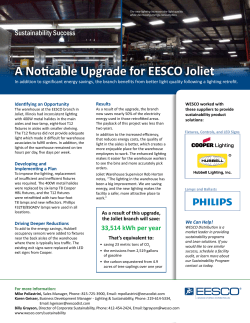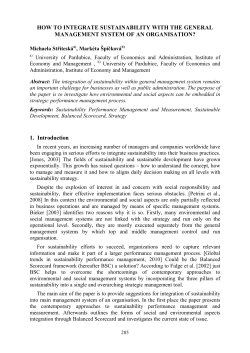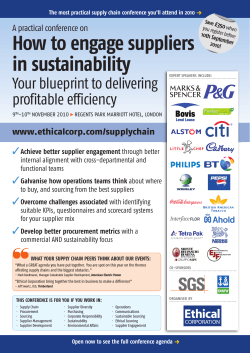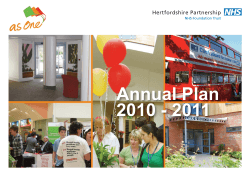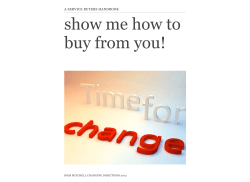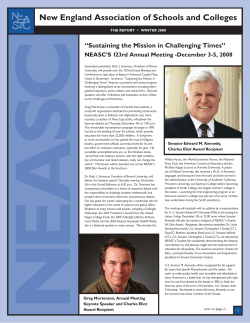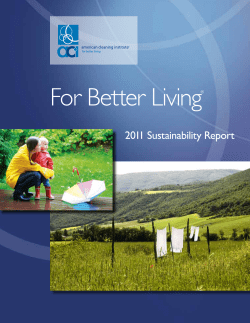
how to evolve sustainability management from risk mitigation
WHITE PAPER Sustainability 3.0: Tapping into New Opportunities | December 2011 how to evolve sustainability management from risk mitigation to revenue generation Sonny Masero Vice President, Business Unit Strategy, CA ecoSoftware agility made possible™ Sustainability 3.0: Tapping into New Opportunities table of contents Executive summary 3 SECTION 1: Challenge 4 Managing sustainability in silos SECTION 2: Opportunity 6 Enabling real-time performance monitoring and timely decision-making SECTION 3: Benefits 10 Achieving an eco-competitive advantage with sustainability 3.0 SECTION 4: 12 Case Study: Tesco SECTION 5: 13 Case Study: Capgemini SECTION 6: 14 About CA ecoSoftware SECTION 7: 15 About the author 2 Sustainability 3.0: Tapping into New Opportunities executive summary Challenge As the spectre of climate change, peak oil and resource scarcity grows, companies are battling to mitigate their exposure to commercial and operational risks through sustainability management. While this approach might help minimise carbon emissions and the reliance on unsustainable natural resources, it fails to give companies the eco-competitive advantage they need to succeed in today’s ‘green’ economy. Businesses also need to be able to exploit sustainability as an opportunity for cost reduction and revenue generation. And for that they need relevant real-time performance metrics and global visibility. Opportunity By leveraging technology, companies can break free from the manual processes, disparate spreadsheets and obsolete data that characterised the first iteration of sustainability management: sustainability 1.0. Furthermore, companies can pass over the incremental step to 2.0, largely defined as replacing spreadsheets with databases and otherwise maintaining manual, non-transparent data collection processes that are still costly to verify and untimely. Instead organisations will be able to take advantage of real-time metrics, simplified reporting and informed decision-making as they traverse the management maturity curve to sustainability 3.0. As well as helping to minimise the environmental and social impact of day-to-day business operations, this approach can highlight opportunities for growth and enable more credible interactive dialogues with external stakeholders. Benefits Sustainability 3.0 technologies and strategies help organisations to mitigate risk and uncover new business opportunities. As a result, sustainability will become an enabler for top line revenue generation. By becoming a leader in sustainability, companies can establish more robust governance, simplify compliance, attract more investment, improve customer retention and reduce costs. In short, they will secure an eco-competitive edge that could make the difference between business success and failure. 3 Sustainability 3.0: Tapping into New Opportunities Section 1: Challenge Managing sustainability in silos Sustainability is reshaping how we live and work. It is influencing the products that consumers buy; the regulations that governments pass; the investments that businesses make. Sustainability’s influence on our decision-making processes is invariably founded on the psychology of risk rather than opportunity. For example, the risk of environmental damage, increased costs, declining natural resources or displaced communities, and the real risks to business that they pose. The prime factors driving today’s sustainability risk agenda are cost reduction requirements, climate change, resource costs and peak oil. These issues will continue to hold considerable sway as the planet reaches a tipping point both in terms of oil production, resource extraction and rising temperatures. If greenhouse gas emissions continue to climb at the present rate, average temperatures are predicted to increase by four degrees (centigrade) by the end of this century1. As our climate changes, water scarcity is also becoming a major threat to the earth’s overall sustainability as well as certain industries—such as manufacturing and mining - which require large volumes of this precious resource. It is estimated that by 2025 nearly a quarter of the world’s population will be living in countries with limited water supplies. Such alarming predictions have prompted many businesses and governments to embark on sustainability initiatives to help mitigate these risks. For example, the EU Emissions Trading Scheme (ETS) will soon enter its third phase for cutting consumption and emissions amongst heavy emitters and will be expanding its reach to the aviation sector. While in California, the Global Warming Solutions Act (AB 32) set the requirement to reduce emissions to 1990 levels by 2020, and the final cap and trade system has been adopted2. The EU ETS and California’s AB32 are just two of numerous regulatory schemes now associated with sustainability. According to a study3 of 30 countries, there are at least 142 standards or laws with some sustainability-related reporting requirement or guidance. Two thirds of these standards are mandatory while the remainder are voluntary. Managing reputational and regulatory risk To comply with such schemes and improve their sustainability credentials, many organisations have introduced a range of environmental initiatives, for example green IT, recycling and energy reduction programmes. Once again, however, the driver has been risk rather than opportunity. As well as the risk of non-compliance, businesses are increasingly recognising the reputational risks that can come with an adverse sustainability track record. Sustainability also presents reputational opportunities in terms of brand distinction and customer loyalty, which can result in an ecocompetitive advantage. Having an eco-competitive advantage means operating a company profitably without any restrictions to growth arising from the availability or cost of natural resources. It also means using sustainability as a springboard for launching new profitable service and product lines that help other organisations limit their impact on the earth’s natural resources, biodiversity and communities. 4 Sustainability 3.0: Tapping into New Opportunities Siemens is a prime example of a company that is no longer looking at sustainability as just a risk to its business operations but an opportunity for growth. In 2010 the company unveiled ‘One Siemens’, its framework for sustainable value creation4. Expanding its Environmental Portfolio, which includes wind turbines, energy-saving bulbs, water reuse systems and smart meters, is one of Siemens’ nine focus areas. The company has an ambitious target to generate more than €40 billion in revenue with its ‘green’ technologies by the end of fiscal 2014. A cohesive value chain To credibly deliver a portfolio of sustainability products and services, an organisation requires an effective governance framework. This can help to ensure that the criteria used to differentiate these products and services by demonstrating sustainability value are not undermined by poor governance. Ineffective governance can significantly harm brand reputation and there are numerous incidents over the last two decades that still taint customers’ views to this day. A sound governance framework can also provide a solid platform for growth. Although profitable growth is fundamental in today’s economic climate, it must come hand in hand with demonstrable environmental and social benefits to achieve a strong eco-competitive advantage. For example, impact investing enables a company to generate financial returns while also achieving a specific environmental or social goal. JP Morgan estimates that capital investment in such schemes could reach between $400 billion and $1 trillion in the next 10 years5. Many of these investments are focused on fundamental needs and services, such as agriculture, water, housing, education, health and energy. For example Google has invested in two early-stage companies that are working to bring innovative new technologies to market in wind and geothermal energy6. Impact investing demonstrates how financial and sustainability objectives can be amalgamated to create a cohesive value chain. As the two disciplines become more closely intertwined, organisations will need to establish an equally integrated framework for sustainability and financial reporting across their entire operation. Collating accurate data for transparent reporting and disclosure To achieve this, social and environmental value not only has to be measured with the same rigour as financial results but also communicated to relevant stakeholders. In the business-to-consumer sector, this communication will increasingly include social media platforms. The metrics needed to measure sustainability performance invariably come from a wide spectrum of devices, facilities and organisations—from server racks in the data centre to smart meters in buildings and partners in the supply chain. This creates a massive data collation and analysis challenge for organisations. For example, when Capgemini started tracking data to measure and report against its corporate environmental objectives, it ended up with a four-gigabyte spreadsheet (see case study on page 13). Such information management challenges are deterring many organisations from expanding their sustainability efforts—and improving their sustainability performance. 5 Sustainability 3.0: Tapping into New Opportunities Companies that fail to resolve the information management dilemma will struggle to shift their sustainability focus from risk to opportunity. As a result, they will miss out on establishing an eco-competitive advantage that would not only benefit their profitability but also the planet. Section 2: Opportunity Enabling real-time performance monitoring and timely decision-making The worlds of IT and of sustainability are colliding. As a result, the way corporate sustainability is measured, managed and communicated is undergoing fundamental change. The extent to which IT is exploited will depend on both the maturity of an organisations’ existing sustainability programme and its attitude towards innovation and technology. Lessons on how to leverage technology to achieve an eco-competitive advantage can be learned from the most unlikely quarters—motorsports. Formula 1 racing has been impacted by the need to reduce costs—specifically through the use of fuel. As a result of a refuelling ban introduced in 2010, teams and drivers have had to rethink their race strategy. This need was exacerbated by the extreme weather conditions experienced in the 2011 Canadian Grand Prix, which meant racing tactics had to be adapted on an almost lap-by-lap basis. Adopting such a flexible approach would have been impossible without constant communication between the drivers and team principals as well as real-time performance metrics. Access to this data created a dynamic feedback loop that enabled the teams to make decisions about how to optimise the performance of both the car and driver. This proactive approach helped achieve continuous improvement throughout the race and impacted the final race results. Similarly, this approach, can also make the difference between strong and weak corporate sustainability outcomes. Escaping the mindset and constraints of sustainability 1.0 Most businesses have yet to establish this type of dynamic feedback loop for tracking their sustainability performance. Although real-time monitoring has become commonplace for tracking financial data, sales performance, or service availability, it has yet to become the de facto standard for monitoring energy efficiency and other key sustainability performance indicators impacting operational costs and revenue. As a result, many companies remain locked in a world of manual processes, disparate spreadsheets and obsolete data: the world of sustainability 1.0 characterised by lone sustainability champions. Escaping this labour-intensive and reactive method for managing sustainability initiatives, particularly energy efficiency programmes, is essential if organisations want to be able to report on—and improve —their performance. Although reporting remains voluntary for many companies, the move towards a mandatory system is gaining momentum. Civil groups, including the Global Reporting Initiative (GRI), have been lobbying 6 Sustainability 3.0: Tapping into New Opportunities the European Commission since early 2011 to introduce new laws that require companies to report on their environmental, social, human rights and governance impacts based on defined indicators. Some countries have already opted to put their own national rules in place. For example in France, companies listed on the country’s stock exchange have been obliged to integrate social and environmental information in their annual report since 2001. These regulations are now becoming more stringent. Despite the trend towards greater regulation, many companies are embracing sustainability solely due to the reputational factor. Staff, investors and consumers alike increasingly expect organisations to be transparent about their impact on the environment—and to demonstrate real and continuous improvements. As a result, more and more companies are choosing to voluntarily report on their sustainability efforts and embrace schemes such as the Carbon Disclosure Project (CDP) and GRI. For example, the number of GRI reports registered in 20107 increased by 22 percent. Unleash the full potential of enterprise IT Going public with sustainability performance objectives and outcomes means organisations must have access to reliable and relevant real-time data. To achieve this, organisations need to make the incremental step from sustainability 1.0 to 2.0 where individual champions are joined by small dedicated teams. Database technology is a key pillar of this second generation of sustainability management, where multiple spreadsheets are replaced with specialist software designed for corporate responsibility reporting and compliance management. According to the GRI, the proportion of companies using software to monitor their sustainability performance increased by 50 percent between 2006 and 20108. An IT-driven sustainability management model not only simplifies the collation, analysis and distribution of performance metrics but also enables organisations to identify opportunities for improvement. By delaying technology adoption companies will also be delaying the financial and energy savings that come with more automated and consistent management procedures. To take full advantage of an IT-enabled approach, organisations need to take a bolder step forward to adopt a 3.0 sustainability solution that features: •Standardised data formats •Centralised repositories •Organisational business structures •Tailored real-time normalised metrics, including energy consumption per unit of output •Flexible user roles •Automated reports and interactive dashboards 7 Sustainability 3.0: Tapping into New Opportunities An enterprise view While it may appear to be the right thing to do, deploying a best-of-breed sustainability solution is not the answer. Organisations need to break free from a siloed process for monitoring and measurement and extend sustainability performance management not only across the entire enterprise but also the supply chain. This cultural change adds an important human dimension to the use of technology for sustainability. A 3.0 solution provides the platform on which performance information can be shared more easily with stakeholders to support change programmes. For example, by collecting operational data for carbon emissions reporting on a global basis, Tesco can see which countries are performing well, and help drive improvements around the business (see case study on page 12). Achieving such an enterprise view is vital to realising corporate sustainability goals, and is what differentiates sustainability 2.0 from 3.0 leading to sustainability being embedded across an organisation’s operations. This third stage in the sustainability management journey is founded on integration and intelligence. By integrating metrics captured by sustainability hardware, such as smart meters, energy-efficient facilities equipment and green IT devices, organisations can gain the intelligence they need to make more informed decisions. This integrated approach is not about just having more information, but about having the right information to support timely decisions being made on a quarterly or even monthly basis. For sustainability to be relevant to the business this integrated collection of data must be connected to strategic goals, and, where possible, provide performance metrics that relate environmental impact to key business targets. The connection to other management information and the alignment of sustainability to core business operations will ensure that progress on sustainability more easily resonates with both the CEO and CFO as well as the CSO. Taking this comprehensive approach will enable organisations to create an Enterprise Sustainability Network and achieve the dynamic feedback loop that proved so valuable to Formula 1 teams and will ensure business makes it across the finish line ahead of its competitors. When an enterprise management view and enterprise sustainability network are combined with a sustainability portfolio and program management (PPM) solution, companies can free up their staff from spending months on data collection and management so they can focus on more forward-looking activities instead. Identifying more financial opportunities By adopting the principles of sustainability 3.0, organisations can establish a consolidated and accurate view of not only energy usage but also other common sustainability KPIs, such as landfill waste volumes, travel carbon emissions and water consumption. Some of which are already featuring in voluntary reporting schemes and could soon become regulated as the sustainability agenda intensifies. 8 Sustainability 3.0: Tapping into New Opportunities Some large companies have already entered the second and third phase of sustainability management, which may account for a recent improvement in reporting quality. According to the GRI, almost half of the reports submitted to the organisation during 2010 were assured, resulting in more accurate and trustworthy data. As well as simplifying and strengthening reporting, sustainability 3.0 strategies and technologies also enable organisations to start identifying opportunities rather than just risks. For example, IT workloads in the data centre can be rescheduled to geographies or timeframes that offer lower prices per kilowatt of power. Companies could also benefit from cash incentives offered by energy providers for curtailing consumption at peak times. To unlock such opportunities, organisations will need to combine sustainability 3.0 software with IT management tools and executive dashboards that support a co-ordinated approach and strategic decision-making. A driver for profitable growth For many organisations, the sustainability journey will begin with a focus on improving internal operations. As a company progresses from sustainability 1.0 to 2.0 and eventually 3.0, this focus will gradually become more outward looking. As well as extending sustainability best practice across their supply chains, companies need to embed the same principles into product/service development and growth strategies. Technology can help facilitate this shift by providing visibility of both sustainability projects and product lines at granular level. For example, Enterprise Energy Management solutions can: •Monitor cost and return on investment •Track alignment against strategic goals •Measure expected and actual social and environmental outcomes •Simplify management from concept through to execution •Allow for portfolio optimisation As a result, companies can prioritise the sustainability activities that deliver the greatest value and identify the most profitable products to develop. Exploiting social media platforms for stakeholder engagement As sustainability becomes progressively more multi-faceted, organisations will have to communicate with a wider set of stakeholders. Thanks to the rise of social media technologies, this communication will increasingly be interactive and immediate. Successful communication via Facebook, YouTube and Twitter requires relevant up-to-date information about sustainability performance and projects. Organisations that linger in the world of sustainability 1.0 and 2.0 will find it very difficult to counteract any negative coverage with accurate statistics about their operations and the associated environmental/social impacts. This will not only damage a company’s reputation but also prevent it from securing and retaining an eco-competitive advantage. 9 Sustainability 3.0: Tapping into New Opportunities With real-time data at their fingertips, companies can use social media technologies to their advantage. This might include developing online content to increase consumer awareness of new ‘green’ products/services or communities that encourage supplier involvement in corporate sustainability efforts. This two-way communication model draws on the Formula 1 example but includes not only internal but also external stakeholders, such as suppliers, investors and customers. For example, Sedex9 uses social media technologies to offer a secure portal for suppliers to store, share and report on ethical and sustainability practices to a subscribed customer base. Section 3: Benefit Achieving an eco-competitive advantage with sustainability 3.0 With the right IT solutions and business strategies in place, sustainability can be managed as both a risk and an opportunity. Whereas once sustainability was seen primarily as an opportunity for cost reduction, it will progressively become an enabler for top-line revenue generation—as demonstrated by Siemens. Environmental Portfolio has proved so successful that Siemens met—and exceeded—its 2011 revenue target of €25 billion one year ahead of schedule. In addition to fueling top-line growth, the product line has helped Siemens’ customers reduce their annual carbon dioxide emissions by around 267 million tons in 2010 The company now hopes to top the 300 million mark by the end of the fiscal year 201110. A lower carbon footprint will remain a key priority for companies regardless of what stage they have reached on the sustainability maturity curve. By leveraging IT to establish a dynamic feedback loop and automated processes, energy efficiencies can be achieved with less expense and effort. As a result, companies can meet not only their own internal carbon reduction objectives but also regulatory obligations and consumer expectations—both of which are becoming more stringent. An IT-enabled model can also help companies adjust more quickly to new sustainability laws and standards, for example the fourth generation (G4) of the GRI guidelines, which are due for release in 2013. Given the rapidly evolving legislative landscape, such agility and automation is essential. Otherwise organisations face considerable manual recalculation when environmental criteria, such as the emission factors used for carbon footprint calculation, are changed. Tesco will be able to avoid just such manual effort through its use of CA ecoSoftware (see case study on page 12). Tesco’s progressive approach to carbon disclosure has helped it secure the “pole position” in the CDP FTSE 350 Report 2011 with the highest disclosure score ever. 10 Sustainability 3.0: Tapping into New Opportunities Minimising reputational risk Sustainability 3.0 technologies and strategies not only mitigate risk by simplifying regulatory compliance, they also: •Protect a company’s reputation by helping them measure and report on their performance more accurately and transparently •Limit reliance on dwindling natural resources by enabling organisations to either reduce consumption or find more sustainable alternatives •Facilitate faster and smarter decisions about environmental and social impacts which in turn helps companies to maintain their licence to operate and investor confidence •Enable a rapid response to negative coverage either in the press or on social media platforms by providing real-time access to metrics Maximising environmental portfolios and financial returns These factors can all deliver an eco-competitive edge, which is sharpened even further when sustainability opportunities are exploited in parallel with risk mitigation. By taking this dual approach, organisations can: •Prioritise investment in sustainability projects/products that deliver the greatest business value •Attract investment from socially responsible funds through integrated financial and sustainability reporting •Reduce operational costs by improving energy efficiency •Boost customer loyalty and spend •Establish their company as a leading ‘green’ brand Companies need to act now to take the eco-competitive lead. As with e-commerce, new entrants with a more IT-enabled business model will overtake those established brands that fail to adapt to the new world—the world of sustainability 3.0. Early adopters of CA ecoSoftware are already benefiting from the availability of high quality and higher frequency data. They are making quicker and more accurate business decisions that deliver sustainable value to their organisations earlier. To succeed in this new operating environment, sustainability needs to be embedded in every area of a business. It needs to be part of the business DNA. Sustainability 3.0 checklist •Automate and standardise data collation and analysis •Make business relevant performance metrics available in real-time •Break free from sustainability silos and take an enterprise-wide approach 11 Sustainability 3.0: Tapping into New Opportunities •Broaden the measurement framework beyond carbon reduction and energy efficiency to other material sustainability impacts •Align sustainability software to organisational structures and processes •Measure value creation as well as cost reduction and mitigation •Exploit social media platforms to share the sustainability message •Look for opportunities not just risks •Use sustainability to drive profitable growth Section 4: Case study Tesco uses CA ecoSoftware to measure, report and analyse carbon emissions across its operations worldwide Tesco is seen as a leader in sustainability and has set itself the challenging target of becoming a zero-carbon business by 2050. In pursuit of its strategic long-term carbon reduction goal, Tesco has set itself industry-leading emission targets in the run-up to 2050. These include: •Halving the carbon emissions from its existing buildings by 2020 (compared with a 2006 baseline) •Halving the emissions from new stores by 2020 (compared with stores built in 2006) •Halving the distribution emissions of each case of goods delivered by 2012 (compared with a 2006 baseline) Carbon emissions reporting is a particular area of focus since Tesco reports its footprint to organisations such as the Carbon Disclosure Project, publishes emissions data in its Corporate Responsibility Report and provides data in other forms to internal and external stakeholders. It is also subject to the UK government’s CRC Energy Efficiency Scheme. Simon Palinkas, of the Tesco Green IT Group, comments, “We had to continuously gather a vast amount of information from more than 4,000 locations and 14 countries. With language issues as well, pulling all that data together into a coherent, simple and easy-to-use way was a huge challenge for IT.” With CA ecoSoftware, Tesco has an accelerated means of collecting and validating carbon emissions data, and a scalable platform that can expand with the company and with its evolving needs. 12 Sustainability 3.0: Tapping into New Opportunities The company uses the system to collect worldwide operational data for carbon emissions reporting, including: •Use of electricity •Diesel for Tesco’s distribution fleets •Gas and oil •Renewable energies •Refrigerants •Business travel “Information is now much easier to collect, and, as it’s all done in real time, we can look at the reports as the data is entered and highlight any issues immediately,” comments Palinkas. “We can see if countries are performing well, and help drive improvements around the business based on the different stages of their carbon reduction efforts.” The solution can also save the company from having to do a great deal of manual recalculation when governments and other organisations change the ‘emission factors’ upon which carbon footprint calculations are based. As Palinkas explains, “With CA ecoSoftware we only need to change the emissions factor and the data is automatically recalculated, which saves us a huge amount of time.” For Tesco, benefits of the solution include: •Increased speed and accuracy in the preparation of carbon emissions reporting •Issues with the accuracy of data input around the world have been reduced and resolved more quickly •Automation has been increased through capabilities such as automatic progress tracking and “click of the button” reporting •New reports are created and used more quickly as reporting and analytical requirements change Section 5: Case study Capgemini improves sustainability performance with CA ecoSoftware As environmental awareness grows, it is increasingly important for organisations such as Capgemini to be able to demonstrate their sustainability credentials. Jon Hampson, Environment Director, Capgemini UK, explains, “Sustainability is no longer just a “nice to have”, it’s a commercial reality. Aside from managing our performance internally, we need to provide insightful reporting about our sustainability performance for analysts, partners and clients on a regular basis.” 13 Sustainability 3.0: Tapping into New Opportunities As well as pressure from customers and partners, Capgemini UK is also subject to the mandatory Carbon Reduction Commitment (CRC) Energy Efficiency Scheme. To demonstrate its commitment to improving sustainability performance, Capgemini UK set some intentionally challenging corporate environmental objectives, focusing on its key areas of impact, including: •Reducing its carbon footprint by 20 percent by 2014 •Improving energy efficiency of its data centres by 20 percent by 2014 •Reducing travel-related carbon emissions by more than 30 percent by 2014 •Sending zero waste to landfill by 2014 However, measuring and reporting progress against its objectives became complex and time consuming. Peter Walsh, Head of Sustainability Business Process Outsourcing at Capgemini, comments, “Capgemini UK was tracking sustainability performance using a four (!) gigabyte spreadsheet, but they wanted to find a way to make the process more rigorous and cost-effective while ensuring that the quality, accuracy and integrity of data was of a sufficient standard to support the ambitious sustainability goals they had adopted.” Capgemini recognised many of its customers were under similar pressures, and launched an Energy, Carbon and Sustainability Business Process Outsourcing (BPO) service to help customers improve their sustainability efforts. Following an assessment of the sustainability management solutions on the market, Capgemini selected the cloud-based CA ecoSoftware solution to support its new BPO service. The solution captures a variety of data from numerous sources, both within Capgemini and from their suppliers, including air travel data from travel agents, electricity and gas meter readings from various facilities, waste and recycling volumes from waste management providers. Walsh comments, “As part of the service, we have defined workflows for capturing, cleansing and uploading data into CA ecoSoftware according to Capgemini UK’s requirements.” By using the CA Technologies solution to support its sustainability service, Capgemini UK has also been able to: •Reduce the costs associated with collecting and managing data, and creating reports by approximately 30 percent so far •Actively manage carbon emissions and waste through better informed business decisions •Gather data to support compliance with the legislative requirements of the CRC Energy Efficiency Scheme •Improve communication relating to sustainability programmes with stakeholders, employees, customers and partners Having implemented the system across the UK organisation within three months, the sustainability business process outsourcing service is now available to Capgemini’s external customers. 14 Sustainability 3.0: Tapping into New Opportunities Section 6: About CA ecoSoftware CA ecoSoftware can help organisations meet corporate energy and sustainability goals such as reducing carbon emissions, managing consumption and cutting energy costs. They can become more efficient when using power and natural resources by providing valuable up-to-date information captured from its environment and by supporting its efforts with a systematic governed approach. This information can be communicated to stakeholders and used to drive continuous improvement. CA ecoSoftware offers a broad range of sustainability management capabilities to help manage an organisation’s sustainability programme from strategy to execution. It also includes a robust suite of carbon and natural resource management to measure, calculate and report on energy use, water, waste and the associated GHG emissions across the enterprise. One can measure the environmental performance of sites, facilities and suppliers through assessments, which provide a method and process for capturing the information more efficiently via web-based questionnaires. With operational energy management, organisations can gain greater visibility into energy and other environmental resources in the datacentre and across the enterprise to visualise, monitor and better manage the use of energy. To learn more about CA ecoSoftware, visit ca.com/ecoSoftware. Section 7: About the author As Vice President of Business Unit Strategy for CA ecoSoftware in EMEA, Sonny Masero helps CA Technologies customers derive business value from environmental sustainability by achieving more with less. He is also responsible for helping CA Technologies improve its own environmental performance across the region. Over the last eighteen years Sonny has gained expertise in sustainable development, energy management and climate change, and has extensive experience of identifying and managing business risks and opportunities in the areas of sustainable business, renewable energy, sustainable products and services, sustainable property, project development, carbon management and GHG emissions assessment and reporting. 15 Sustainability 3.0: Tapping into New Opportunities CA Technologies is an IT management software and solutions company with expertise across all IT environments—from mainframe and distributed, to virtual and cloud. CA Technologies manages and secures IT environments and enables customers to deliver more flexible IT services. CA Technologies innovative products and services provide the insight and control essential for IT organizations to power business agility. The majority of the Global Fortune 500 rely on CA Technologies to manage their evolving IT ecosystems. For additional information, visit CA Technologies at ca.com. 1 guardian.co.uk 2 arb.ca.gov/cc/capandtrade/capandtrade.htm 3 Carrots and Sticks, Promoting Transparency and Sustainability, 2010 4 siemens.com/about/en/values-vision-strategy/one-siemens.htm 5 Impact Investments, An emerging asset class, JP Morgan, November 2010 6 google.com/green/collaborations/investments.html 7 globalreporting.org/NewsEventsPress/PressResources/2011/SustainabilityDataMoreReliableSaysNewFigures.htm 8 globalreporting.org/NewsEventsPress/PressResources/2011/SustainabilitySoftwarePressRelease.htm 9 sedexglobal.com 10 siemens.com/sustainability/en/environmental-portfolio/products-solutions/index.htm Copyright © 2011 CA. All rights reserved. All trademarks, trade names, service marks, and logos referenced herein belong to their respective companies. This document is for your informational purposes only. CA assumes no responsibility for the accuracy or completeness of the information. To the extent permitted by applicable law, CA provides this document “as is” without warranty of any kind, including, without limitation, any implied warranties of merchantability, fitness for a particular purpose, or noninfringement. In no event can CA be liable for any loss or damage, direct or indirect, from the use of this document, including, without limitation, lost profits, business interruption, goodcan, or lost data, even if CA is expressly advised in advance of the possibility of such damages. CA does not provide legal advice. Neither this document nor any CA software product referenced herein shall serve as a substitute for your compliance with any laws (including but not limited to any act, statute, regulation, rule, directive, policy, standard, guideline, measure, requirement, administrative order, executive order, etc. (collectively, “Laws”)) referenced in this document. You should consult with competent legal counsel regarding any Laws referenced herein. Some information in this publication is based upon CA or customer experiences with the referenced software product in a variety of development and customer environments. Past performance of the software product in such development and customer environments is not indicative of the future performance of such software product in identical, similar or different environments. CA does not warrant that the software product can operate as specifically set forth in this publication. CA can support the referenced product only in accordance with (i) the documentation and specifications provided with the referenced product, and (ii) CA’s then-current maintenance and support policy for the referenced product. CS1943_1211
© Copyright 2025

